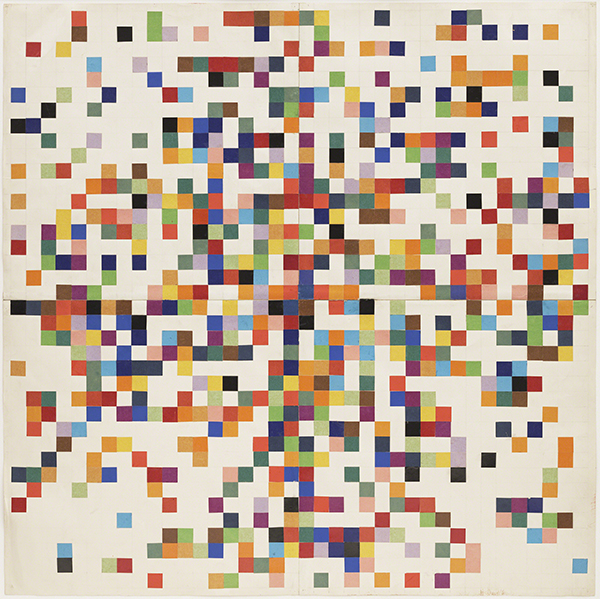Pride Month 2023: Ellsworth Kelly
Let’s celebrate the life of one of the pioneers of the Color Field movement in American modernism, Ellsworth Kelly, to mark the beginning of LGBT Pride Month. Kelly was one of the many gay artists, both men and women, associated with the New York School of painting. Color Field is the exact opposite of the action painting strain of Abstract Expressionism, and it certainly laid the groundwork for the Minimalism movement that surged during the 1960s.
 |
| Ellsworth Kelly (1923–2015, U.S.), Spectrum Colors Arranged by Chance II, 1951. Collage of cut-and-pasted color-coated paper and pencil on four sheets of paper, 38 ¼" x 38 ¼" (97.2 x 97.2 cm). Courtesy of the Museum of Modern Art, New York. © 2023 Artist or Estate of Artist. (MOMA-P1648) |
After living in Paris for 6 years and moving to New York in 1954, Kelly eliminated all traces of line, brushstroke and form from his painting. While admiring the brilliant color of the Abstract Expressionists, he rejected their emphasis on an emotional resonance in abstract painting. He opted to explore the idea of color as subject without any associations.
The first group of this nonobjective exploration of color was Kelly’s 1951 series of eight paintings entitled Spectrum Colors Arranged by Chance. This series of collages explored the random distribution of spectrum colors in pieces of uniformly cut squares of painted paper on neutral backgrounds.
While developing the Chance works, Kelly was already exploring painting with contrasting colors—usually two—in oil. These works were hard-edge, pure color fields. In the mid-1960s, he merged these two tendencies in a series of hard-edged, spectrum-influenced paintings on multiple panels. He called these works simply Spectrum, again numbered one through eight. Some of them are monumental in scale (V through VIII). In these works, such as Spectrum III below, Kelly explored a range of 13 colors within the spectrum.
 |
| Ellsworth Kelly, Spectrum III, 1967. Oil on canvas, 33 1/16" x 9' (84 x 276 cm). Courtesy of the Museum of Modern Art, New York. © 2023 Artist or Estate of Artist. (MOMA-P0786) |
A number of exhibitions held in the 1960s focused attention on changes occurring in American abstract painting. Abstract imagism, systemic painting, and, the most enduring, color field painting, were terms used to identify this new trend in abstraction. The broader term of post-painterly abstraction was applied to the work of this group of painters to differentiate the trend from the action painting of Abstract Expressionism. The exhibitions illustrated just how many younger painters were trying to break with what they felt was the tyranny of Abstract Expressionism’s emphasis on individual, personally charged brushstroke.
While these artists used many different approaches, the emphasis was on pure abstract painting with a subordination of brushstroke and paint texture. One of the logical end results of color field painting was a movement that took the emphasis on flat surface rather than illusion and the idea of the artwork as an object to its greatest extreme of reduction: Minimalism. The paintings of Ellsworth Kelly are variously related to Hard Edge painting, Color Field, and Minimalism.
As a child in northern New Jersey, Kelly spent much time observing the natural world around him and the shapes of various insects and plants. Observation is the core of Kelly's paintings, the result of the shapes, shadows, and other elements of the world he saw around him. A stint in the U.S. army during World War II (1939–1945) as a camouflage painter further informed his interest in shadows and optically stimulating shapes. After serving, he studied at the School of the Museum of Fine Arts in Boston, where his painting style was academic and figurative.
In 1948, Kelly moved to Paris, where he underwent influences divorced from the action painting of Abstract Expressionism that was dominating American art. There, he absorbed the influences of numerous periods of art from the Renaissance to Pablo Picasso (1881–1973) to the Surrealists. He was attracted to the idea of automatic creation championed by the Surrealists, and over time found himself ridding his painting of any extraneous elements such as marks, lines, brushstrokes, and contours.
On a trip to the Musée d'Art Moderne de Paris, Kelly had an epiphany when he was more drawn to the unusual shapes of the windows than the works of art on the walls. An early series of “window” paintings formed the foundation of his aesthetic from then on. He explored the abstract possibilities of form and colors in basic elements of the visual world such as shadows, the corner of a building seen in perspective, or the color of a road sign.
Correlations to Davis programs: Explorations in Art 2E Grade 5: 1.7, 1.8; Explorations in Art 2E Grade 6: 1.7; Experience Art: 1.2; The Visual Experience 4E: 5.2


Comments